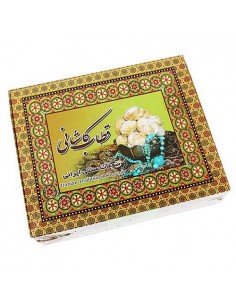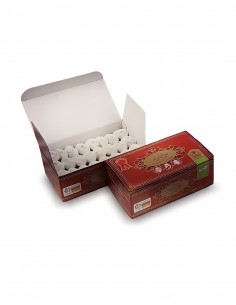Qottab
Qottab (or Ghottab) is one of the most famous traditional Iranian cuisine. Although it is a famous souvenir of Yazd and Kerman, it is trendy among all Iranians. This article will provide information about buying Qottab (Ghottab) and its recipe and ingredients.
Qottab Review, Select, and Shopping Guide
The enchanting delicacy of Qottab, a centuries-old Persian pastry, has captured the hearts of dessert fans across the globe. This exquisite sweetmeat, known for its compelling fusion of flavors and textures, captivates the palate of those partial to nuts, honey, or the delicate layers of flaky pastry. Undeniably, Qottab has a treat in store for every dessert lover.
Qottab Ingredients
The creation of Qottab involves a few select yet potent ingredients that lend this pastry its distinctive taste. The primary constituents are flour, butter, almonds, pistachios, powdered sugar, rosewater, and cardamom. The dough is skillfully crafted by amalgamating flour, butter, and a dash of salt until it attains a crumbly consistency. The filling is an aromatic blend of finely ground almonds and pistachios combined with powdered sugar, rosewater, and cardamom. This fragrant mixture is then rolled into petite orbs and nestled in the heart of each pastry.
Qottab, Ghottab, or Ghotab has been baked and consumed for hundreds of years! This traditional cookie is not one of the fatty and sugary harmful confections, but rather one with a high nutritional value. It is typically prepared in two flavors, pistachio and walnut, and resembles a morsel made from special dough filled with walnut or pistachio kernels. The kernels inside are sometimes mixed with powdered sugar or honey and placed in the dough.
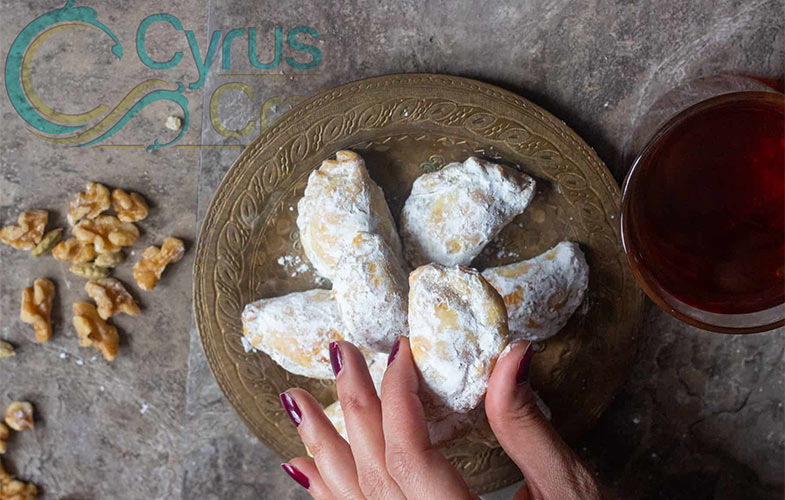
Cyrus Crafts; Luxury & Unique Products
The History of Qottab
The saga of Qottab harks back to the grandeur of ancient Persia, where it was meticulously crafted as an exclusive indulgence for the monarchy. 'Qottab' translates to 'bag-shaped' in Persian, a fitting nomenclature for this charming pastry. With time, Qottab gained widespread acceptance as a favored dessert among the common folk, thus ensuring that successive generations inherited the cherished recipe.
Qottab Characteristics
You may be interested to know that traditional Qottab sweets have layers. That's why you feel a pleasant sensation when you put this delicious sweet in your mouth.
The first layer of the Qottab pastry is a bread-like layer, which gives it its distinctive texture and sweetness. The rest of this Egyptian dessert comprises additional layers covered with powdered sugar for added sweetness. The bread surrounding this sweet is more like oil bread. What is the white layer on the cake? When the outer layer of the bread is made like Qatab, it is covered in sugar powder, and this white layer is related to the sugar powder placed on the bread.
The most delicious part of a Qattab is its middle layer, which gives texture and flavor to the bread. The middle layer contains three special powders that make it so tasty. Sugar, cardamom, and almonds are the ingredients that makeup Qottab, a traditional cookie in Iran.
Because the middle layer of Qottab contains nutritious ingredients such as almond powder, this sweet is one of the traditional sweets; apart from its taste, it also has nutritional value.
| Information | Amount (per 100gr) |
|---|---|
| Calories | 420 Kcal |
| Protein | 7.50gr |
| carbohydrate | 58gr |
| Fat Content | 18gr |
Nuts Used in Qottab
While the almond and pistachio duo may be the reigning champions in the world of Qottab, a fascinating array of variations summons other nutty contenders into the ring. Some culinary virtuosos infuse the pastries with walnuts, cashews, and even hazelnuts, each bestowing their unique flavors and textures upon the pastry. These alternative nut fillings serve as a delightful detour from the well-trodden path of traditional Qottab, allowing for a thrilling exploration of divergent flavor symphonies.
Qottab Syrup
One of the quintessential elements that catapult Qottab into a league of its own is the divine syrup that lovingly veils the pastry. This ambrosial concoction is a harmonious blend of honey, rosewater, and saffron, heated gently until it transforms into a sticky and aromatic nectar. Once the golden and fragrant Qottab pastries emerge from the oven, they are promptly immersed in this syrupy heaven, soaking up the sweetness and floral notes. The syrup imparts a luxurious quality to the pastry, amplifying the overall gustatory journey.
Qottab Benefits
Qottab is a symphony of flavors and a trove of health benefits. This delicacy's primary ingredients, almonds and pistachios, are nature's powerhouses brimming with wholesome fats, dietary fiber, and protein. These super nuts and sometimes even dried fruits have been linked to a cornucopia of health benefits, such as enhanced heart health, diminished inflammation, and improved cognitive function. Nevertheless, as with all sweet indulgences, it's imperative to enjoy Qottab in moderation, ensuring it harmonizes with a well-balanced diet.
According to the mentioned materials, Qattab is not simply a sweet made from flour or sugar and has a lot of benefits.
- Almonds are suitable for your skin due to their high vitamin E content and can prevent premature aging. On the other hand, its antioxidant properties can be very effective for your health. Also, due to their unsaturated nature, almonds are valuable and necessary for the body.
- In traditional Iranian Qottab Shirin, cardamom is a crucial ingredient. Cardamom's aroma is soothing and relaxing; adding just one seed to your tea will have an impressive effect. Therefore, what better way to give ourselves a unique cardamom taste than buying a delicious Iranian Qottab?
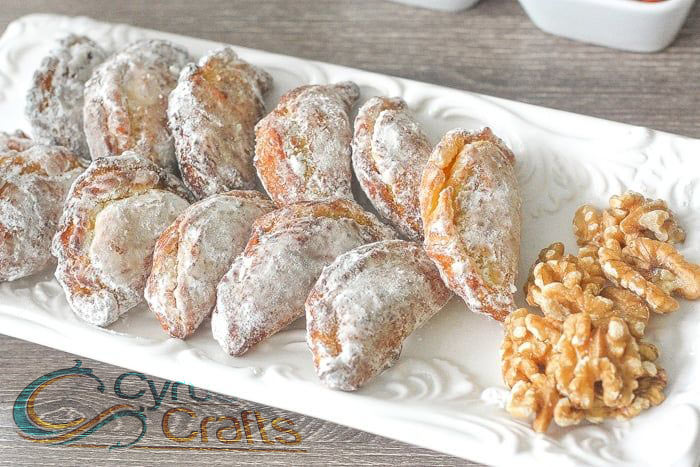
Qottab Taste
Qhottab has a layered texture and two flavors, like some Iranian sweets like baklawa. Qottab sweets are prepared in two types: walnut and pistachio. The pole consists of two outer layers and the brain. The outer part is made with dough, and in the preparation of the dough, this cab is made from egg yolk, baking powder, liquid oil, milk or yogurt, and flour, which is decorated with powdered sugar, and the inner core of the Qottab is almond powder, powdered sugar, and chicken cardamom. He does. And they form rose water and honey.
Qottab Origin
Qottab is small, dusted with powdered sugar pastries, a staple dessert served at numerous Iranian festivities and celebrations. Although it is believed that the cookies originated in Yazd, they are now widely consumed across Iran.
Traditional Variations of Qottab
While the classic Qottab recipe is a perennial favorite, a tapestry of traditional variations of Qottab has woven itself into the culinary landscape. Certain regions sprinkle cinnamon into the nut filling, while others infuse the pastry with orange blossom water for a refreshing citrusy twist. These variations are a testament to the vibrant cultural diversity of the regions where Qottab is savored, with each version bringing its unique flavor narrative to the table.
Qottab in Different Cultures
Though the roots of Qottab trace back to the ancient lands of Persia, this delectable delight has traversed across borders, enthralling taste buds worldwide. In the heart of Iran, Qottab is more than a mere dessert—it's a cherished tradition savored during festive times and special occasions. Its popularity extends to neighboring lands such as Afghanistan and Azerbaijan, where Qottab is a beloved accompaniment to a steaming cup of tea. Recently, the Western world has also been spellbound by Qottab's exotic allure and delicate pastry craftsmanship.
Qottab Recipe
In the Qottab recipe, we will first make and let the dough rest. While the Ghotab's dough rests, it is time for filling preparation. Finally, we will assemble the Qottab, and it is frying time.
- Make the dough: Combine the egg yolks and oil until well blended, then add the powdered sugar and yogurt. Stir in cardamom before gradually adding the dry ingredients; mix thoroughly—Knead for three to five minutes or until no longer sticky (much like bread). Put the dough in a bowl and cover with plastic wrap and a kitchen towel. Set aside for 2 hours. Since the dough doesn't have yeast, it won't rise.
- Make the filling: Grind walnuts or Persian pistachios in a food processor or blender until finely chopped. Add powdered sugar and cardamom.
- Roll out the dough: After two hours, roll out the dough, fold it in half, and then fold it again to have four layers of dough. This will help the dough to have layers and be crispy.
- Shape the pastries: Roll the dough out again, and using a round cookie cutter, cut out circles and fill them with the walnut or pistachio filling. Seal the edges, then pinch and fold over as shown in the photo. Alternatively, You can use a fork to seal the edges or roll the walnut or pistachio-filled dough into a ball and ensure the edges are all pinched together.
- Bake and serve: Bake the Persian pastries in the oven for fifteen to eighteen minutes until golden. Instantly roll them in powdered sugar and serve on a platter.
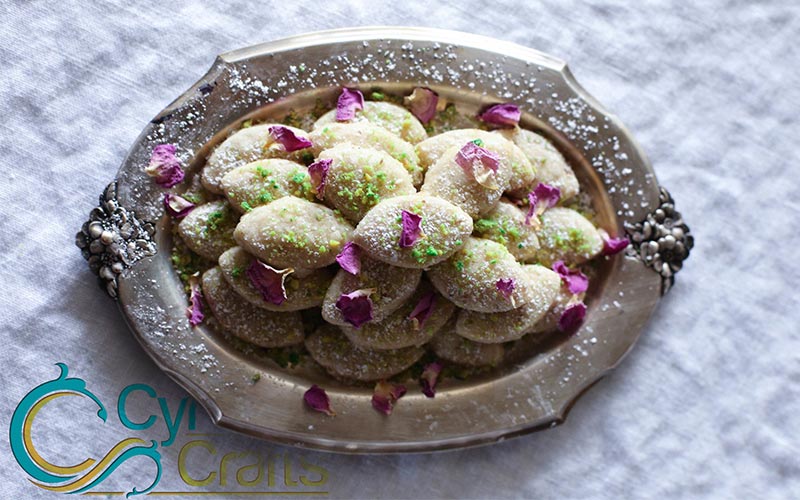
Qottab Storage
Store these pastries in an airtight container in the fridge for up to 4 days. It's best to serve them at room temperature. You can also freeze Qottab for up to 3 months. Thaw them in the fridge overnight and let them come to room temperature before serving.
Other Iranian Pastries
Though Qottab may often steal the limelight in Iran's culinary scene, there exist two other exquisite Iranian pastries that unequivocally merit applause — Gaz candy and Sohan. Akin to a nougat, Gaz is a succulent sweet, its chewy consistency promising a delightful surprise with each bite. This Persian delicacy is lovingly crafted from a harmonious blend of pistachios, aromatic rosewater, and honey, offering a unique flavor profile that will satiate any sweet cravings.
On the other hand, Sohan is an enchanting symphony of saffron-infused brittle toffee that harmoniously melds with almonds and pistachios. Its satisfyingly crunchy texture and intoxicatingly rich flavor have rendered it a cherished dessert across Iran. With every bite of this brittle, one is transported to the vibrant markets and warm kitchens of Persia, making it more than just a dessert — it's a delightful experience of Iranian culture and tradition.
Last Word about Qottab
It is hoped that you have grasped "Qottab," a nutty, healthy, and nutritious Iranian snack. Qottab and other delicious Iranian products have been produced and exported to other countries for several years. Still, we intend to contribute to their production and export by relying on the capabilities and knowledge available on CyrusCrafts.
CyrusCrafts will provide you with high-quality and unique products as part of its specialized activity in preparing, selling, and exporting the best Qottab (Ghottab Persian cookie) so that you can have an excellent and one-of-a-kind taste and serve your guests uniquely and differently.


